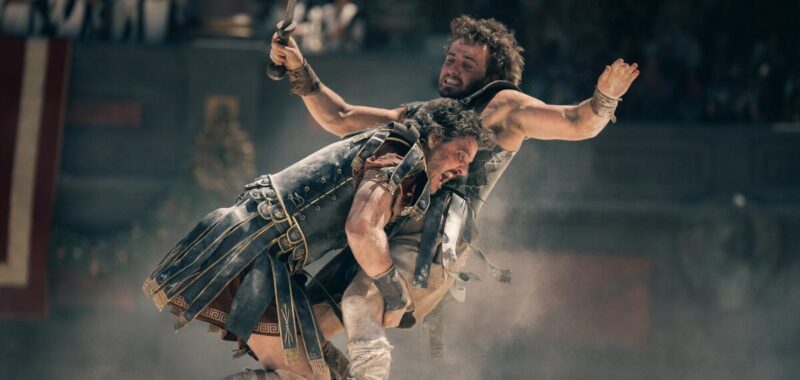Like its predecessor, “Gladiator II” is inspired by history. That doesn’t mean it’s bound by actual historical facts, however.
Now in theaters, Ridley Scott’s follow-up to his 2000 epic “Gladiator” follows Lucius (Paul Mescal), the son of Russell Crowe’s warrior Maximus, during the reign of twin emperors Geta (Joseph Quinn) and Caracalla (Fred Hechinger). It features characters based on real historical figures as well as those created for the film.
Much like its predecessor, “Gladiator II” centers on spectacular gladiatorial games held at the Colosseum, which pits captive warriors like Lucius against other men as well as animals in combat. In honor of the wild contests featured in the film, we asked experts what types of outrageous events actually happened in the Colosseum.
There may not have been sharks, but there were sea battles
The Colosseum today might not appear to be a site that could have hosted water battles, but experts say they happened.
“Sometimes there would be a naval battle that was staged” as part of the games, says Andrew Scott, a professor of classical studies at Villanova University. “That was maybe a little bit rare, but there is a lot of attestations of that.”
He explained that when the Colosseum was opened during the reign of emperor Titus, historical reenactments of naval battles from the 5th century BC were staged. But even before then, the first Roman emperor Augustus is said to have staged sea battles involving thousands of participants at a different venue.
The presence of sharks at these battles (called naumachiae) is quite unlikely, however. “I can’t think of an instance where an ancient source talks about that sort of wildlife,” says Scott. According to the book “The Colosseum,” by Keith Hopkins and Mary Beard, historian Cassius Dio wrote that “horses and bulls and other domesticated animals” were brought out as part of Titus’ aquatic show.
Semi-aquatic wildlife, such as crocodiles, were involved in other spectacles: “The Colosseum” mentions Dio’s account of one of Augustus’ animal hunts featuring “36 crocodiles.”
In fact, all sorts of animals were part of the show
Historians say many more animals than humans were involved in entertainment events at arenas like the Colosseum. They were generally used in staged hunts, as well as public executions. They were also pitted against each other.
According to Scott, such events allowed an emperor to show off what sort of animals could be procured from the far reaches of the empire that people in Rome had never seen before.
The animals said to have been featured in various Roman spectacles include hippopotamuses, elephants, rhinoceroses, bears, ostriches and big cats like lions and tigers.
“Historian Cassius Dio talks about an animal that he refers to as a cameleopard,” says Scott.
A cameleopard may evoke the image of a mysterious exotic big cat, but it’s what ancient Romans called giraffes based on their appearance.
Sometimes emperors were gladiators, too
Generally, emperors sponsored gladiatorial games to boost their popularity and to showcase their might. But at least one emperor participated in the arena spectacles in order to further bask in the public’s attention.
Commodus, the emperor who was the basis for the character in “Gladiator” (2000), was “an emperor we are told actually performed in the arena,” says Scott. “There’s this long section in a book by the Roman historian Cassius Dio where he talks about how Commodus participated in the hunting games [and] performed as a gladiator.”
The real-life counterparts to “Gladiator II’s” emperors were a slightly different story.
“I don’t think we have direct evidence of Caracalla participating in the games, but there’s a lot of talk in the ancient sources about how he liked to drive his chariot,” said ”I think in this period, there can be sort of a melding of this emperor persona with the popularity of an arena performer.”
Hollywood has nothing on ancient Romans’ own Colosseum stories
It’s no surprise that blockbusters like “Gladiator II” embellish historical facts to make sure audiences are entertained. But Hollywood storytellers aren’t the only ones. Ancient Roman historians and poets alike wrote about the thousands of people and animals involved in various arena events. But the most shocking (at least to modern sensibilities) might not have been a combat or hunting simulation.
According to “The Colosseum,” the ancient Roman poet Martial wrote that the opening events of the amphitheater included reenactments from mythology. Supposedly, the story of how the half-human/half-bull Minotaur came to be was acted out in the arena between a woman and a live animal.
But whether Martial meant this literally or was using a little creative license of his own is up for readers to debate.

